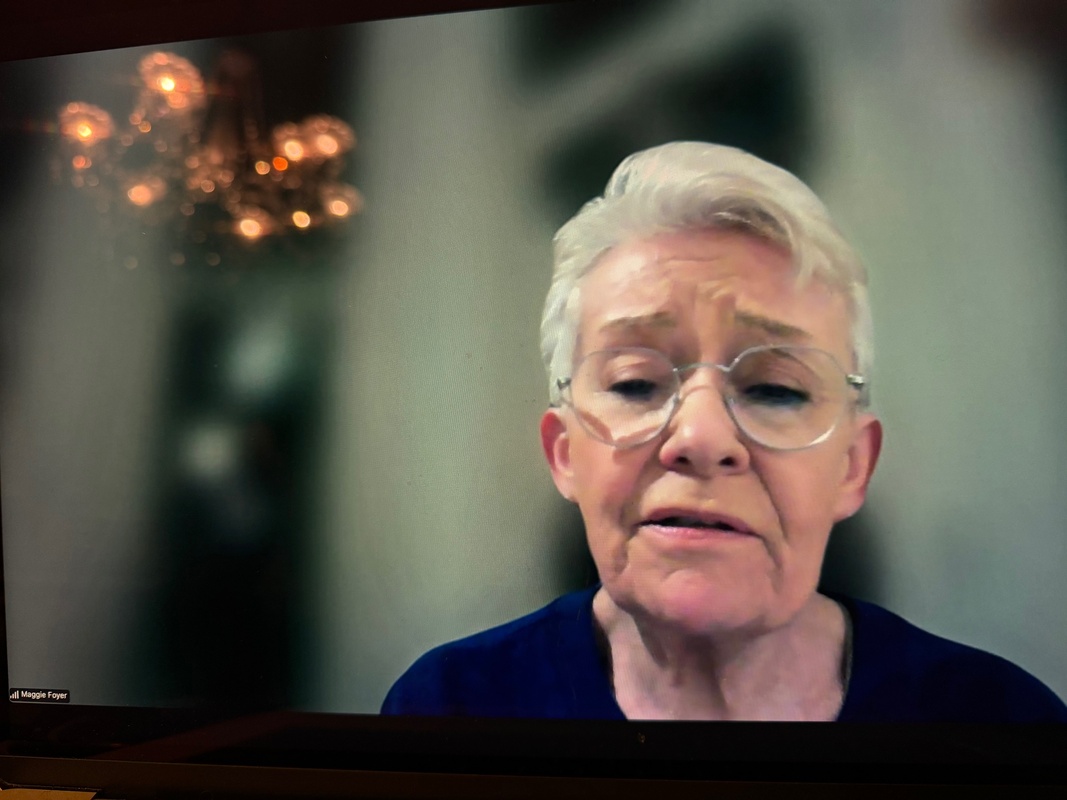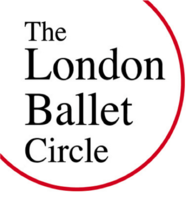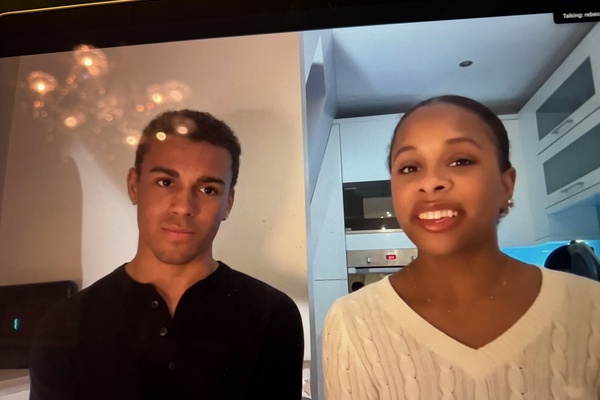
Rebecca Stewart and Emile Gooding ‘In conversation’
with Maggie Foyer
10th March 2025
Rebecca and Emile were both winners of the London Ballet Circle’s Dame Ninette de Valois Award in 2024 and are now artists on the Aud Jebsen Young Dancers programme with the Royal Ballet (RB). Following the Circle’s AGM, they were both welcomed to the evening’s conversation by the LBC’s Chair, Susan Dalgetty Ezra, who also welcomed celebrated dance writer, Maggie Foyer.
Maggie opened the conversation with the dancers by commenting that they had both just ‘survived’ a week of Romeo and Juliet. Emile responded that it had indeed been a busy week but he had always dreamed of being in that ballet, so opening with it on the main stage was exciting and well worth the long days. Rebecca said they had both been townspeople and had also appeared in the ballroom scene. ‘Wearing those stunning costumes’ said Maggie. Rebecca agreed they were glamorous and helped to portray the Capulet character – although they were quite heavy to wear.
Turning to Emile, Maggie asked about the fighting and whether he survived. His response was in the negative – he died. But, he said, it’s great to be a part of it, to watch the impressive action of some of the participants. He’d never done anything like that before; learning and then really going for it on stage had all been fun.
The dancers explained that following their third year at the Royal Ballet Upper School they had both been invited on to the Aud Jebsen programme which provides a one-year apprentice contract with the RB. As such, they are essentially members of the company, taking part in all classes and rehearsals although they might also have just one additional weekly class on their own. And they were delighted that since starting on the programme, they had both been given full contracts with the company.
Rebecca hails from America, so why did she want to join the RB, asked Maggie. She replied that from an early age she was sure she wanted to dance but wasn’t sure what style she preferred. Around 12 or 13 she had discovered videos of the RB on YouTube, and it wasn’t like any dance company she had previously seen. Every dancer was playing their individual part and the whole company appeared completely unified. She was young and it all seemed so far away; nevertheless, she made it her goal to one day audition for the Royal Ballet School. She had taken part in their online summer intensive in 2020, had been spotted and asked to audition. She did that online as well and as a result joined the Upper School in 2021.
Emile’s story is somewhat different, having already performed quite extensively in musical theatre. At Tring School for the Performing Arts he had studied many dance styles but hadn’t decided which he really wanted to pursue. He had a part in Matilda the Musical in London from which he went on to play Billy in Billy Elliot, this part homing him into both the skill of and love for ballet, and in due course leading to him auditioning for the RBS.
As both dancers clearly have backgrounds in a range of styles, Maggie wanted to know how that had affected their attitude to ballet. Rebecca had taken part in several competitions as a youngster, which had involved many different routines. She felt quite comfortable with contemporary and even more jazzy styles, and believed that this versatility offered a considerable advantage – especially with the way in which the ballet repertoire is developing. She agreed that competitions, while they are sometimes decried, do help develop control of the nerves and encourage the dancer to attempt more difficult variations without too much fear. Just a few minutes on the stage, and you’ve got to get it right! Those skills, developed at age 10 or 11, remained relevant and useful to her at nearly 19.
For Emile, who already had a rich experience in the theatre, the major adjustment came when he went from being a lead figure in a London production to just another student in their 1st year at the RBS. It was great to be on stage so young and he was so pleased to have done the part; he felt it would enable him to be fearless in approaching whatever he might go on to dance.
Both Rebecca and Emile had danced Rhapsody in Paris; that must have been exciting? They agreed it had been terrifying but incredible working with students from other schools. A difficult work, but so great to have the opportunity to express yourself on a stage like the Palais Garnier. And in his second year Emile had also been to the Hamburg Ballet school and danced in a John Neumeier ballet. Great experience!
They had both taken part in a Hannah Joseph piece in Legacy, a production put together by Joseph Sissens involving dancers of colour from different companies, performed in the Linbury Theatre. They described this space as having a very different feeling from the main stage because the audience is much closer and their energy can be transmitted to the dancers so much more easily.
Rebecca had also been involved in Insights with the Dance Theatre of Harlem; had she worked with them before? One of my teachers was a principal dancer with the company, she explained. Probably the first time she had been aware of dancers of colour in the world of ballet was during a DTH summer intensive held at one of her local studios in America. ‘That company and its history has had a huge impact on me.’
How about choreography? Were they interested? Emile replied that at the moment he simply loves to dance; he would not have the courage to stand in front of a group of dancers, but certainly did not rule it out for the future. Rebecca, on the other hand, had already tried her hand at it. In her 2nd year at the RBS she choreographed a short dance sequence on 14 of her student colleagues. Learning to command the room was a challenge, but she really loved the whole process – and the piece had been shown as part of Autumn Draft Works at the Royal Opera House in 2023.
Were there awards which gave you a particular boost, then inquired Maggie. The Valerie Adams Award at the end of my time at White Lodge, responded Emile quickly. Moving from White Lodge to the Upper School was a big jump, and that award, for musicality, gave him such a tremendous boost for the transition.
And Rebecca? The Outstanding Female Graduate in my 3rd year – ‘I’m very grateful for that’. The award for her dissertation was also pleasing, particularly as that was something achieved outside the studio. And of course, the Aud Jebsen contracts which they both held.
Rebecca is very interested in academic subjects, especially dance theory, and her dissertation concerned the impact of role models on dancers of colour. She feels that as ballet is essentially a European art form there are fewer role models to encourage young dancers. She cited in particular Misty Copeland in the USA, although there are now several within the RB.
Moving across the ‘Bridge of Aspiration’ from school into the company was also a major transition, said Maggie. The dancers agreed; it had been somewhat strange going into a working environment but they both felt the company was very familiar with absorbing young graduates and treated them very well. Nevertheless, they had to come to terms with the fact that those dancers up to whom they had looked from afar were now in the same class, working alongside them.
To facilitate that transition they had already taken part in several productions, along with many of their colleagues in the 3rd year at the Upper School. For instance, Rebecca had been a Gypsy in Don Quixote, then a Snowflake and an Angel in The Nutcracker, as well as a Swan in Swan Lake. The ethos of the RBS closely matched that of its parent company and newly promoted dancers were already well versed in the importance of classical techniques, of footwork and musicality, of Ashton and MacMillan. Emile noted that the student learned so much at the RBS about the history and background of the company. His own dissertation, in fact, had been on the work of Sir Frederick Ashton.
And what about other choreographers, wondered Maggie. For Emile working on Maddaddam with Wayne McGregor had been a great experience. It had been very special working with the actual choreographer there in the studio. Also being part of the ‘compressed’ group of dancers in Crystal Pite’s Light of Passage – he explained that this created a sort of joint energy which was an amazing experience. He went on to speak of Jiří Kylián, whose choreography also considerably interested him.
Rebecca spoke of working with Joseph Toonga in Dusk, a new piece which premiered in the recent Encounters bill containing very different styles of dance – hip-hop and pointe work. It had been a great challenge and she felt the experience had matured her considerably. She also mentioned Dwight Rhoden, an American choreographer and Co-Founding Artistic Director of Complexions Contemporary Ballet in New York. In her 2nd year she had danced one of his solos, Imprint/Maya, dedicated to the poet Maya Angelou for the Lynn Seymour Award for Expressive Dance. She had felt and enjoyed the various aspects of history coming together during the process of developing that piece.
And do they have dream roles? For Emile it changes with each production….you’re in, say, Romeo, and you see the principal roles up close and you think that you’d like to do them….. However, he cited Colas in La Fille mal gardée, which he had performed in his graduate year, as a particular dream. Rebecca agreed about her dream steadily changing with each new show, but cited Clara in The Nutcracker as being a terrific role. She was also fond of Balanchine, some of which she had danced at School of American Ballet summer intensive programmes. Energetic, and fun!
You’re both at the start of your careers, said Maggie, but a dancer’s career is not very long. Do you have any idea what you might want to do when active dancing becomes no longer possible? Emile expressed the desire to stay in the studio and, he hoped, become a coach; he liked the idea of ‘owning’ a ballet and being able to pass it on to younger artists. For Rebecca academia remained attractive; she would like to broaden herself intellectually, although broadly still in the world of dance.
What enormously articulate and well-rounded individuals, said Susan. In thanking them, and Maggie, most sincerely for a most interesting evening’s conversation, she wished them both the very best of luck in their dancing careers.
Trevor Rothwell 21-03-25
© Copyright London Ballet Circle




